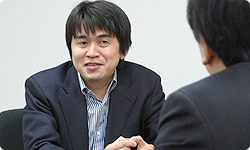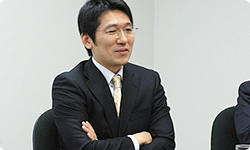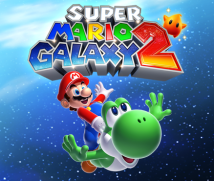3. Mario Games Possess Variety
When I saw Mario Galaxy 2, I felt like it was really packed full of fun ideas. It was crammed full ever since the early stages of development, but what kind of a process did you go through to achieve that?
Since we were making a full-fledged sequel, we couldn’t just have a new character show up. We needed something to serve as a completely new axis for the game to revolve around. At first, that was the concept of “more,” but later we focused on the concept of “switching.”
What’s “switching”?
That’s when you do something like push a button, and the surrounding world suddenly changes.
Oh, I see. The button changes the environment - and not just a little, but in a big, dynamic way.
Right.
Why did you decide on that?
I thought we needed something that would make a significantly different impression than the first game. At first, when we had the idea of using the engine from the first game as a foundation, I think everyone thought of Majora’s Mask.
When we made Majora’s Mask after Ocarina of Time, we adopted the “three-day system.”11 That’s a system that suddenly changes the game world. 11Three-day system: Within the game, the world will end once a certain three-day period has passed, so to keep playing the player must return to the morning of the first day.

Oh, so for Mario Galaxy 2 as well, you tried to think of a system whereby you could change the whole game world.
Right. But when we actually tried to do it, it was hard and just wouldn’t come together.
I knew from all the trouble we had with Zelda that you have to get all the various elements to fit. Sometimes you have to give up on things you’ve made up to that point.
You lose a lot of different things.
I was afraid of that, so I decided we shouldn’t get too hung up on creating a new axis for the whole game to revolve around and I told Hayashida-san that all we needed to do was dedicate ourselves to making interesting contents.
That’s right. Making Mario games has always been about conducting experimental developments for what can possibly be fun ideas, throwing out what doesn’t work, and tying together what’s left over. Koizumi-san and Miyamoto-san told me that, so I decided to change my policy and, instead of getting hung up on the concept of “switching,” to just make something fun.
Is anything leftover in the game from when you were focused on “switching”?
It appears in a number of elements. As for the overall image suddenly changing, there’s the stage with panels that flip from red to blue and back . And then there’s the “slow effect.” You jump on a button and the whole scene shifts into slow motion . And there’s also what we call “tick-tock blocks”— blocks that change at timed intervals . Those are ideas we thought of during the “switching” phase.
And ponds freeze and lava turns into ice.
Then, after we had changed policies, we started talking about how Mario games always possess a lot of variety. That was when we came up with the Spin Drill and Cloud Mario .
I see. Now I’d like to ask you about Mario’s new actions. How did you come up with the idea for the drill?
Ever since the last game, Miyamoto-san had been really fixated on holes you could use to pass through to the other side of a sphere, so…
I’m guessing he said you weren’t making full use of the spheres unless you had more of that.
You guessed it! (laughs)
It was like he was giving us homework!
Going into holes and coming out the other side of a planet was like homework left over from the previous game. I wondered what we could do, and came up with the idea of a drill. We started testing it right away, but drilling through the sphere to get to the other side alone didn’t really make for a game.

I suppose it wouldn’t. (laughs)
It took us a month or two to figure out how we could turn that into fun play. We tested a number of ideas, and came up with something like puzzles. For example, if there’s a high mountain you can’t climb by jumping, you can do it by digging from the opposite side .
I like the way that drill looks. And it’s a nifty gadget game-wise.
The designers debated whether they should make a “Drill Mario.”
A Drill Mario?
I know, it’s weird. (laughs) We didn’t really think it was right for a transformation, so we decided to make it an item. On another note, when we were making Rock Mario , Koizumi-san told me all kinds of stuff during that process.
Why is that?
I was the one who made the controls for Goron Link 12 in Majora’s Mask, so with regard to Rock Mario, I wouldn’t let him rest until I was satisfied. 12Goron Link: A character in Majora’s Mask. When Link puts on a Goron mask, he transforms, becoming able to roll around at high speeds.
(laughs) How did you come up with Cloud Mario?
Cloud Mario was a character we came up with when we were experimenting with making platforms by spinning. We thought clouds would make good platforms, so when you spin, it creates a cloud. If you could do that an unlimited number of times, you would reach an incredible height.
But that wouldn’t make for a good game.
Right, so we set it so that you can only do it three times .
Some people were suggesting that we have the cloud platforms move, but the whole point is that they stack up right where you are. And since they hold still, you don’t have to hurry. You can relax and take your time.
I see.
But even though you can only do it three times, the cloud stacks up and you can reach all kinds of places, which is fun. It was a bit of a headache for us developers, though.
There are some places you would rather the player couldn’t reach.
Right. The cloud is an incredibly powerful item for people who want to try out different ways of playing.
Can you take shortcuts?
Yes, you can. And there are 1-Up Mushrooms in the most unlikely of places as a reward for finding them. (laughs)
